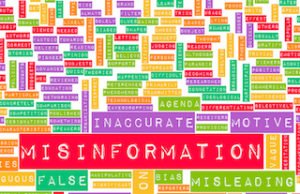In today’s Internet age, reputation crises are common. OnFacebook, hardly a day goes by without newsfeeds buzzing about a celebrity, sports figure, or politician making a gaffe and then apologizing about it. When these mistakes go viral, they enter the Internet’s permanent “memory” and become easily accessible to the public via Google (or other search engine).
Of course, you know this. What you might not know is how damaging negative Internet content can be to a person’s reputation, especially someone who works in a sensitive, highly regulated field such as financial services. As observers of the Glenn Neasham incident already know (See Part 1 in this series – link below), an arrest and conviction (wrongful in Neasham’s case) for theft or fraud can literally end a financial advisor’s career, resulting in years of financial hardship. But not all reputation crises rise to this level.
In the prior article in this series (link below), we presented a process for assessing a reputation incident, along with a three-tiered severity scale:
- Damage so minor you can safely ignore it.
- Damage of medium significance, which can grew into something larger if you ignore it.
- Damage so severe that it could literally destroy your company if you let it.
As we mentioned, medium issues might be a regulatory action for an administrative error, a negative comment about you in an article in the trade press or general media, or a pattern of negative complaints on a consumer review site. The good news: You might be able to fix a medium-level problem yourself without incurring the hassles and expense of retaining a reputation-management consultant. Here are some things to consider before you begin your DIY project.
First, admit the reality of your situation. As Herbert Tabin and Craig Agranoff, authors of Do It Yourself Online Reputation Management, suggest, “Hope is not a strategy.” If negative content about you and/or your firm is on the Internet, just ignoring it won’t make it disappear. If the issue rises to the medium tier, you must take action soon. Procrastinating only makes your DIY fix more difficult.
Second, exhaust all avenues for taking down negative content. People commonly believe there is no recourse once damaging content goes online. Not true. The webmasters for small, private sites might remove an offensive page if you politely explain the problem. When the webmaster’s name isn’t visible, searching Whois.com, a database of domain registry information, may uncover it. Search engines such as Google also have procedures and forms to initiate page takedowns. The reasons are somewhat limited—for example, pages with outdated information or missing pages, inappropriate content appearing in SafeSearch filtered results, Social Security or credit-card numbers appearing in search results, bank account numbers or images of personal signatures appearing on the Web. Others websites such as Yahoo and ZoomInfo have similar guidelines. Just search their FAQs or Google them to uncover the steps to follow. In the European Union, court action has guaranteed a person’s right to have information removed from the Internet. No such law exists in the U.S., and experts believe future prospects are bleak, mainly because American culture values the right to free expression more than the right to privacy.
Third, accept the notion of business transparency. Perhaps you’ve given this lip service in the past. That’s fine. But now you must get serious about full disclosure. To this end, consider sharing more background about your business decisions, more details about product or service offerings, more guidance on transactions and customer-service procedures, and more information about your firm’s principals and staff. In short, you must lift the veil on your company.
Fourth, become a publishing machine. Publishing is the implementation stage of transparency. The goal? To push damaging content down in search rankings. More on this in a minute.
Fifth, accept that fixing your reputation and keeping it clean in the future will be a long-term project.Improvement will take weeks and months, and keeping your newly scrubbed reputation pristine will take diligent work for years to come. No one promised you a rose garden when it comes to reputation management. But the benefits of diligent oversight are compelling.
So what goes into a DIY reputation fix? Here are some tactics to consider:
- Build numerous social-media profiles. When you join a social-media site and fill out a profile, that page typically gets a high Google rank. If you build enough profiles—Tabin and Agranoff suggest you create 25 of them—negative information will usually fall lower in the rankings. For them, the five most important profiles to create are:
- ZoomInfo
They also recommend filling out profiles for 20 other sites, including Digg, MeetUp, TumblR, and Vimeo.
Now, as you build your profiles, don’t go wild. Completing 25 in a day or two may lead Google to ignore the pages. Instead, do one every day or two to maximize the profiles’ legitimacy in Google’s eyes.
- Share photos on sites such as Instagram, FlickR, Imgur, Photobucket, and Picasa, among others. The idea is to post photos showing you doing something positive. Search engines crawl the Internet for photos as well as text. So if your name is in the photo’s title and tags, it can show up in Google results. Sending your friends and colleagues to the photos will then increase their ranking and ability to push down bad content. The same holds true for sharing videos on sites such as YouTube and Vimeo.
- Engage in thought-leadership publishing. Start by creating a blog to share business-related ideas. Using publishing sites such as WordPress and Blogger, you can share your reactions to industry news, your thoughts about emerging financial products and strategies, and your professional accomplishments. Publish insights that make a positive impression and that position you as a leader in your field. Once you create a blog post, repurpose it as an article for a trade publication, a piece for your client newsletter, and as “click bait” for social-media. The point is, the more thought leadership content you post on the Internet, and the more people read it, the heavier its “push-down” weight will become.
Related to blogging is so-called guest blogging. This is where you approach another blogger to publish content that originally appeared on your own blog. If the blogger agrees, you would typically offer the person the same opportunity on your site. - Finally, begin issuing press releases whenever you or your firm makes news. Googling “press release format” will show you the right document format. In writing it, avoid puffery, exaggeration, or any content that isn’t legitimate news. Once you have your press release written, send it to a “pay-to-play” news release distribution company. The three main ones are PRNewsire, BusinessWire, and MarketWired. There are also free PR services such as Free-Press-Release, PR.com, and PRLog. Once they receive your release, they will disseminate your content to newsrooms and websites both locally, nationally, and around the globe. The wider the distribution, the more a paid-site will charge. In a few days, Google will then index your release and if enough people read it, rank it highly on your search-results page.
Other fix-it strategies to try include:
- Step up your social-media participation. If you normally only post on Facebook or LinkedIn, once a week, do it several times a week instead. Then add a couple other networks to your to-do lists. Also get active on industry communities such as Insurance Forums.
- Enlist the support of friends, family, and clients. Encourage them to read and link to the content you publish. This will improve your content’s search rankings, pushing negative content even further down.
- Create a lot of content, but post judiciously. Again, if you blizzard the Internet with content, Google may not respond favorably. It’s better to publish methodically, with a focus on quality, not overwhelming quantity.
- Create additional websites, using the keywords people use to find you on the Internet.
Our last suggestion is perhaps the most important. As alluded to earlier, don’t expect quick fixes. Repairing a moderately severe reputation problem is a long-term proposition. Work steadily at creating your content, and you will likely see it rise in search rankings over the coming weeks and months. Conversely, problematic content should begin to sink lower—eventually so low that, for all practical purposes, it becomes invisible.
When this happens, credit yourself with a reputation win. But remember, online reputation management is a never-ending process. Keep monitoring what people say about you, keep assessing any negative content that appears, and keep making DIY fixes when warranted. However, if your reputation issue becomes as dire as Glenn Neasham’s, it’s time to call in a professional, the topic of the final article in this series.
See also:
• How to Survive a Reputation Meltdown, Part 1: How to put threats in the proper context
• How to Survive a Reputation Meltdown, Part 2: How to analyze and repair on online reputation problem
For more information on reputation management, please visit the National Ethics Association’s Ethics Center. For more information on affordable errors and omissions insurance for low-risk financial advisors, visit E&OforLess.com.













